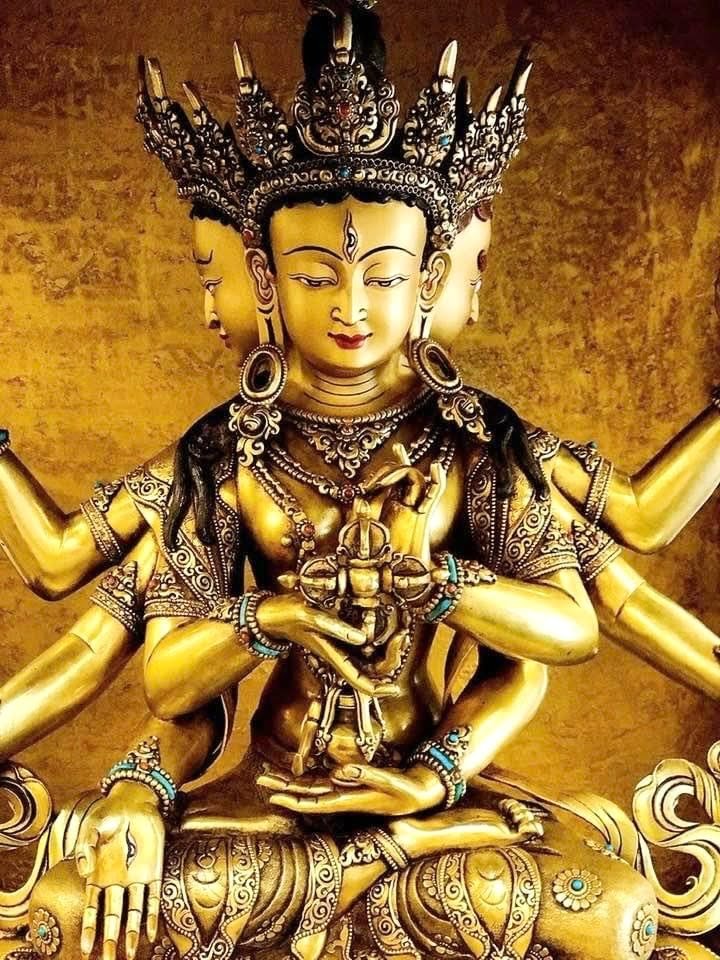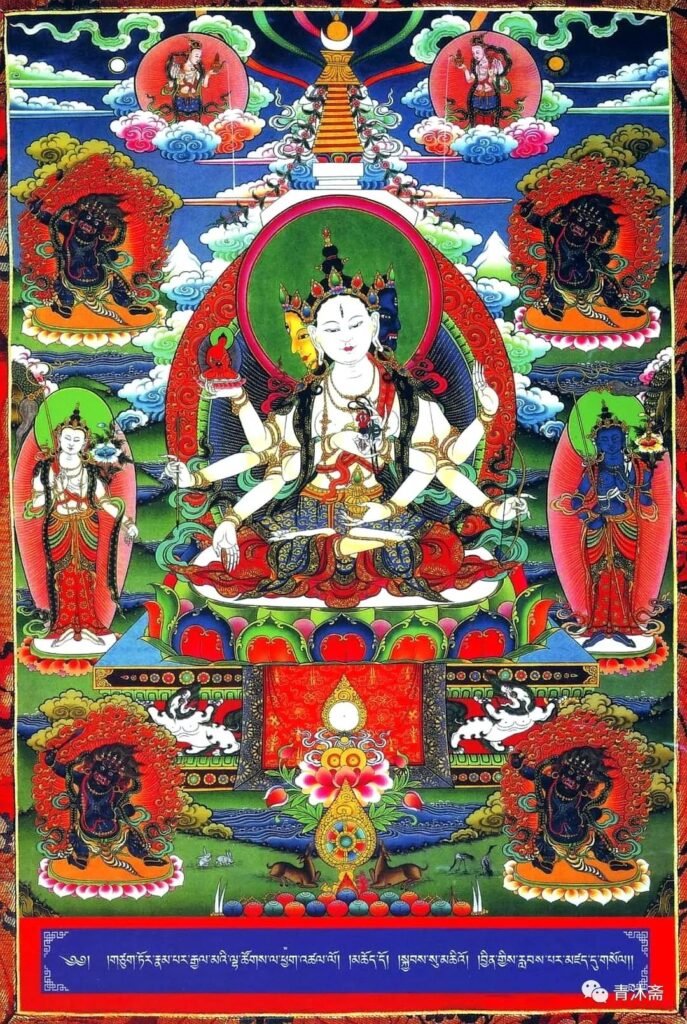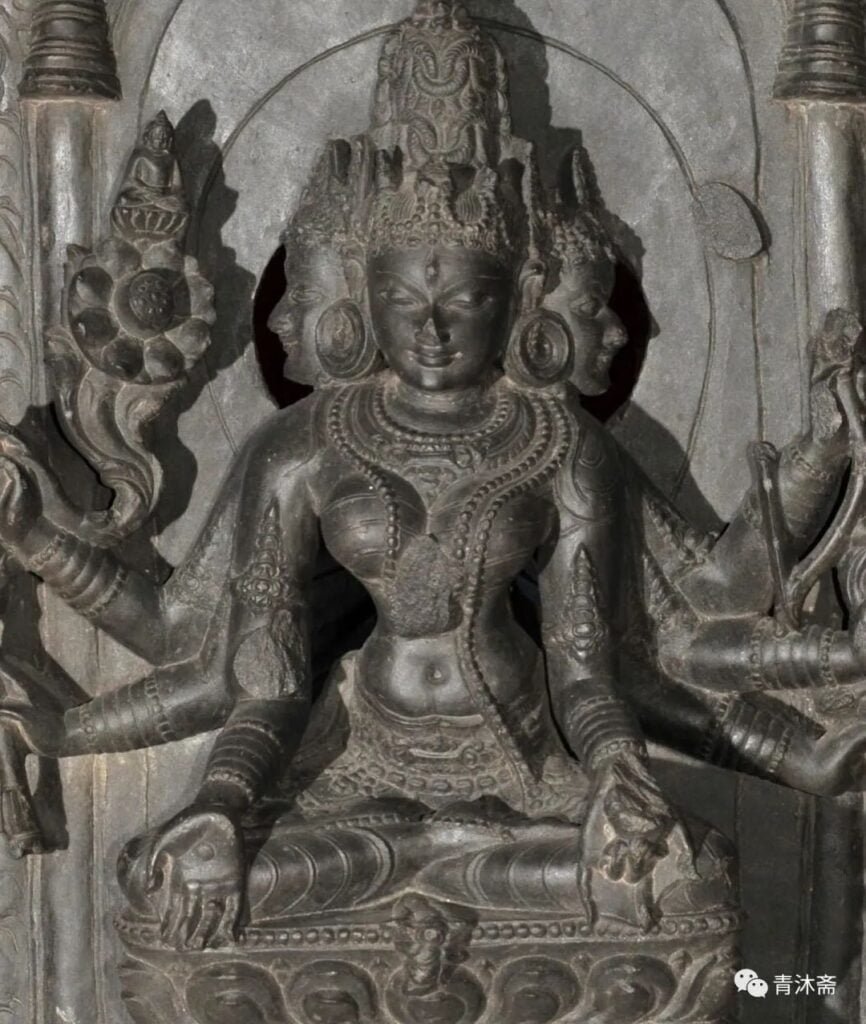The Roots of Usnisavijaya: The Source of Enlightenment
According to the “大方便佛報恩經” (ཐབས་མཁས་པ་ཆེན་པོའི་སངས་རྒྱས་དྲིན་ལན་བསབ་པའི་མདོ།) Usnisavijaya is identified as the source of all Buddhas, embodying the wisdom vital for their path to enlightenment. The “Mahaprajnaparamita Sutra” asserts that the perfection of wisdom, Prajnaparamita, is regarded as the mother of all Buddhas, signifying her profound role in Buddhist teachings.
Discover the transformative teachings of the “Ushnisha Vijaya Dharani Sutra,” a Buddhist scripture promising limitless life and freedom from suffering. This ancient text guides followers on a spiritual journey, offering practices to attain endless longevity and wisdom.

Sacred Images for Blessings:
According to the sutra, creating an image of Ushnisha Vijaya, a deity symbolizing immense longevity, is a powerful practice. This involves weaving a pure cloth by a young girl and painting the deity with intricate details and sacred symbols. Placing this image in a stupa (a Buddhist shrine) surrounded by divine figures enhances its sanctity. The deity is depicted with a thousand rays of light, seated on a lotus moon disc, and possessing three faces and eight arms, each symbolizing different aspects of spiritual power and compassion.

Integrating the Divine Feminine in Tantric Practices
The Ritual of Devotion: Devotees are encouraged to follow a specific ritual. It begins with a day and night of strict observance of moral precepts in front of a relic stupa. Then, offering a thousand varieties of gifts in front of the image for fifteen days, while reciting the sutra, brings forth the deity’s presence, fulfilling all desires.
Stupa Construction for Spiritual Gain: Building a stupa, an important Buddhist structure, using precious materials like gold, silver, or crystal, and adorning it with lotus seats and protective deities, is another vital practice. This ritual includes offerings of fragrant flowers and incense, believed to extend life and enhance wisdom. Regular recitation of the sutra in front of the stupa, especially on specific lunar days, is said to grant a long life, comparable to the deities.
Benefits of Recitation: Constant recitation of the sutra, either daily or for an extended period, is believed to lead to a significant increase in lifespan and wisdom. It also offers the promise of freedom and spiritual abilities equal to celestial beings.
Breaking Free from Bondage: For those bound by physical or spiritual constraints, reciting the sutra is said to offer immediate liberation. This aspect of the sutra highlights its power to alleviate all forms of suffering.
Namgyalma: A Beacon of Life and Wisdom
Namgyalma, known in Sanskrit as Vijaya and in Tibetan as གཙུག་གཏོར་རྣམ་རྒྱལ་མ།, stands among the three longevity deities in Tibetan Buddhism. As an incarnation of Vairocana Buddha, Namgyalma is revered for her immense compassion and ability to grant longevity and blessings. She also holds a unique power to purify negative karma, especially those actions that show disrespect towards Buddhist tenets and symbols.

Iconography of Namgyalma: Symbolism in Thangka Art
In Thangka art, Namgyalma is depicted with three faces and eight arms, radiating a pristine white aura, symbolizing her pure and unblemished nature. Her appearance embodies both beauty and sanctity.
- The Three Faces of Wisdom and Compassion: Namgyalma’s central face is white, symbolizing peace and tranquility. The left face, black, exhibits a wrathful expression, signifying her power to overcome obstacles and challenges. The right face, yellow, represents growth and prosperity.
- The Eight Arms of Protection and Fulfillment: Each arm of Namgyalma holds significant objects, such as the vajra, bow, and arrow, symbolizing different aspects of spiritual attainment and worldly fulfillment.
Mantra of Longevity and Enlightenment
Chanting Namgyalma’s mantra, “Om Ami Dhare Dara Dharin Svaha,” is believed to extend one’s lifespan, enhance wisdom, and lead to ultimate Nirvana. Practitioners focus on her image and mantra, especially on specific lunar days, to purify their karma and attain spiritual liberation.
Namgyalma’s role in Vajrayana Buddhism extends beyond mere symbolism. Her presence in Thangka paintings and meditative practices represents the embodiment of wisdom, compassion, and the divine feminine, playing a crucial role in the spiritual journey of practitioners. Her iconography and teachings continue to inspire and guide those on the path to enlightenment.

Embracing the Divine: The Majestic Ushnisha Vijaya Dharani Practice
Unlock the spiritual essence of the Ushnisha Vijaya Dharani, a profound Buddhist teaching revered for its promise of purity, longevity, and spiritual mastery. This sacred text guides practitioners in venerating the Ushnisha Vijaya, a powerful deity symbolizing ultimate purity and wisdom.
The Divine Form of Ushnisha Vijaya:
Ushnisha Vijaya, residing within a sacred stupa, is depicted in radiant white, with three faces and eight arms, each adorned with precious jewels. Seated in a diamond pose on a multicolored lotus and sun cushion, she embodies spiritual strength and purity. Her faces – white, yellow, and blue – each bear three eyes and convey different aspects of her divine nature.

Sacred Attributes and Symbolism
Her right side holds a vajra, a red lotus supporting Amitabha Buddha, and an arrow, symbolizing her power to grant wishes. The left side displays a bow, a noose, a fearless gesture, and a treasure vase, each representing aspects of protection and compassion. Above her sits Vairocana Buddha, with bodhisattvas on either side, signifying her connection with other divine figures.
Ushnisha Vijaya is a youthful and exquisitely beautiful deity with three faces, each adorned with three eyes. Her countenance exudes grace, and she wears an array of precious ornaments that emit a radiant glow, resembling the autumn moon. Her right face is serene and golden, while her left face displays a fierce expression. Furthermore, her eight arms hold various symbolic objects, including a vajra, a lotus, a bow, an arrow, and a treasure vase. She resides within a Buddhist stupa, where practitioners pay homage to her.
Surrounding Deities and Guardians:
Ushnisha Vijaya is not alone; she is surrounded by celestial beings and guardian deities. In the space above her, a majestic Buddha and Bodhisattvas gather, while her heart center houses Vajrasattva. Flanking her sides are two attendants, one holding a fly whisk and the other a lotus. In front of her stand the immovable King of Vajra, the Lord of Desire, the Blue Staff King, and the Mighty King, each wielding vajras and other symbolic implements. These guardian deities protect and assist in her worship.
The Ushnisha Vijaya Practices:
The Ushnisha Vijaya practices vary, but they share a common purpose – to invoke her blessings and protection. There are five main texts associated with Ushnisha Vijaya, including sutras and dharanis. They provide guidance on rituals and mantras to connect with her divine energy.
The Purpose of Meditating on the Deity’s Form:
Meditating on the various forms of the deity, such as the three-faced and eight-armed white Ushnisha Vijaya and the two-armed yellow Ushnisha Vijaya, serves the purpose of letting go of our attachment to conceptualizations of self. The name “Ushnisha Vijaya” signifies the Buddha’s unbeatable and ever-victorious power. During the four-day consecration, these forms, which emanate from the crown of Shakyamuni Buddha, hold specific significance.

The Significance of Different Forms:
- Three-Faced and Eight-Armed White Ushnisha Vijaya: This form is particularly beneficial for increasing the lifespan of sentient beings and achieving Buddhahood. It is especially relevant as the lifespan of beings in heavenly realms is predetermined, while human existence is subject to impermanence. Therefore, the practice of this form is of utmost importance.
- Two-Armed Yellow Ushnisha Vijaya: This manifestation is a response to the request of Avalokiteshvara for the benefit of sentient beings. It possesses extraordinary power against harmful curses, spells, and dark practices. Anyone who prays to or recites her mantra can avoid falling into the three lower realms, extend their lifespan, and ultimately attain Buddhahood. The benefits of this form align with those of the black-form Ushnisha Vijaya.
- Six-Armed Black Ushnisha Vijaya: This form is an emanation from the crown of Shakyamuni Buddha, in response to a request from Longevity Buddha Amitayus. It is particularly effective in dispelling curses, spells, and dark practices. Practitioners who pray to or recite her mantra can avoid falling into the three lower realms and extend their lifespan, eventually achieving Buddhahood. The protective qualities of this form benefit those who practice it.
Receiving Blessings and Accumulating Merit:
Ushnisha Vijaya is known for her immense blessing power and rapid responsiveness. In addition to receiving consecrations and practicing this deity, accumulating merit through offerings, praises, circumambulation, and other forms of devotion can bring immeasurable benefits. It can help eliminate various obstacles and fulfill one’s wishes.
Addressing Challenges in Visualization:
For those who find it challenging to visualize the six-armed form, it’s essential to understand that transforming into the deity’s exact form is not the primary objective. Instead, the focus should be on taming one’s mind, becoming a virtuous person, and harmoniously living within a community. Spreading the teachings of Buddhism for the benefit of others is also crucial.
Directly Seeing the Deity through Practice:
The ability to directly see the deity through practice is not solely dependent on external manifestations. Rather, it hinges on realizing one’s own true nature. Understanding the nature of one’s own mind and recognizing that everything is an emanation of the deity is a profound aspect of spiritual practice. Daily activities, such as eating and sleeping, can become part of the spiritual path when this realization is attained.

Achieving a Connection with the Deity:
The deity has never been separate from those who have faith in her. Understanding one’s own intrinsic nature is crucial, and realizing that everything is an emanation of the deity’s presence. Engaging in virtuous actions, living harmoniously within a community, and sharing the teachings of Buddhism with others for their benefit are ways to connect with the deity.

